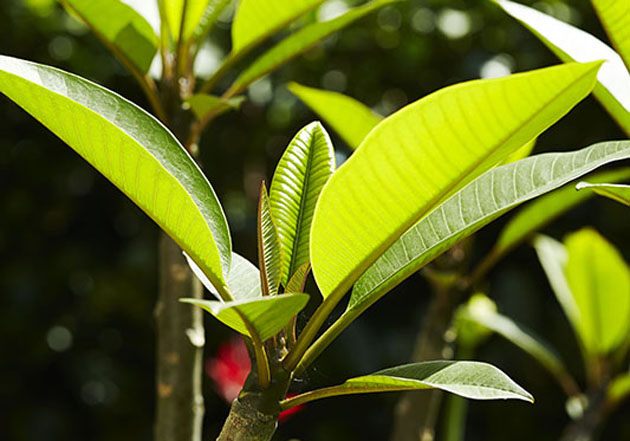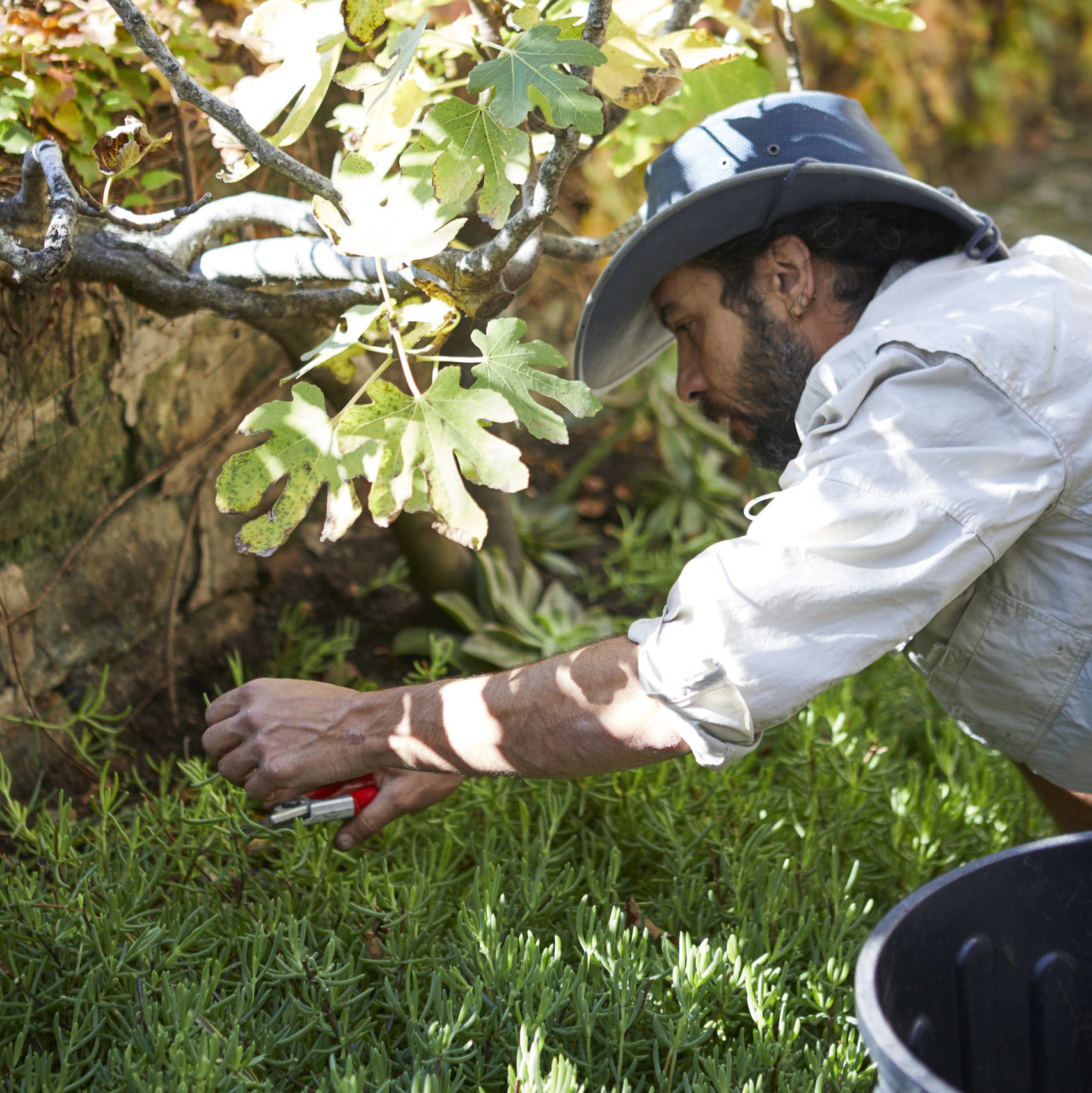Sweltering days and parched soil are typical of Australia’s summer months and it’s during this time when our plants require extra care and attention.

Additionally this year, raging bushfires, dust storms and smoke haze have impacted our natural environment. Tending to our garden’s needs this summer is more important than ever and Horticulture Manager, Gianmarco Vetrugno, shares Pepo Botanic Design’s advice about maintaining a healthy garden at this time of the year.
How much water does a plant need?
Varying climatic conditions tend to highlight the specific needs and particular requirements of individuals plants.
For example, long periods without rain or watering can reveal the amount of water that an individual plant requires on a daily basis in order to prosper. And you may be surprised to discover that some of the plants in your garden are thankful for the dryer conditions.

Taking a look around Sydney, for example, thousands of frangipanis are positively thriving, thanks to the water restrictions and reduced rainfall this summer. Bountiful flowering and verdant green leaves are visual ‘popping’ in gardens across the city gratefully enjoying the dry conditions.
In fact, over watering can kill some varieties, cause root rot and precipitate conditions like bacterial leaf spot disease in succulents, for example. Exotic plants and non-native varieties on the other hand, require ample moisture to flourish, and many yearn for a good soaking, depending on the species.

“Ideally, the roots of a plant should dry out completely before the next watering cycle, which could mean in some instances, watering every second or third day,” advises Gianmarco from Pepo Botanic Design. “It is also important to cover the full width of the root system when watering, which is generally the breadth of the canopy above.”
Shady conditions too will determine how much water is necessary for optimum health with plants growing in hot and exposed areas, requiring more moisture.
As a rule of thumb, plants that are native to Australia and indigenous to the area in which they are planted, will tend to adapt more readily and thrive in those conditions. For example, Banksias and varieties of Westringia tend to suit the Sydney environment particularly well.
Your garden’s unique hydrology should also be assessed. Underground water sources and troughs affect natural undulation, water movement and distribution in the area and these considerations will affect how much additional moisture will be required.
Plan how and when to water
While our water usage is currently determined to a large extent by regulatory bodies, when and how we quench our plants requires individual consideration, depending on your garden’s environmental conditions.
Current level 2 restrictions in Sydney limit the use of irrigation systems to 15 minutes per day per watering station, (providing you have a rain sensor installed), before 10am and after 4pm. Watering with buckets is also permitted at these times.

“It’s important to make the most of your watering time,” says Gianmarco Vetrugno.
“Start by checking the irrigation system to ensure it functions efficiently and that components such as sprinklers, nozzles and valves are working, because they generally need to be replaced every five years.”
“Drip system heads should be positioned above the ground and it’s crucial to ensure that the mechanism has not been covered by vigorous vegetation growth,” he adds.

The method of watering should be determined to a large extent by the needs of your plants. Tropical varieties for example prefer to be bathed in spray, whereas Mediterranean succulents like the Blue Fox Tail Agave, prefer a drip system to nourish their growth.
Given the current restrictions, Pepo recommends watering in the morning around 6am, to minimise the chance of fungal outbreaks and avoid the risk of the leaves burning in the sun. In the evening, 5pm is an ideal time, as it provides an opportunity for the plants to absorb much of the moisture before nightfall.
Mulching – less is more
Preserving moisture is essential to good plant health and this is best achieved through regular mulching.
Pepo’s Horticulture Manager, Gianmarco Vetrugno, recommends spreading a 25 mm layer of locally sourced organic tea tree mulch around the base of the plant. Not only does this help to preserve moisture, it releases nitrogen to enrich and insulate the soil and it smells beautiful too.
Fresh leaf-based mulches offer optimum protection, provided they are not spread too thickly. Other varieties such as wood chip manage to prevent evaporation but tend to draw moisture from the soil, away from the plant. Plus they can be slow to decompose.

As well as spreading mulch thinly, the Pepo Maintenance team advises clients to rotate the coverage regularly to keep it fresh. A ring of foliage also demarcates the ground around the base of a tree and deters foot traffic, which can pack down the soil and affect the health of the plant’s root system.
Use the right fertiliser
Keeping soil well cultivated and nourished is essential, especially in dry and harsh conditions. In general, Australian soil is low in phosphorous and Pepo Botanic Design advocates regular soil testing and treatment.
Fertilising the soil is an essential part of the maintenance regime. “A slow release fertiliser is best in summer,” says Gianmarco. “We also avoid organic fertilisers such as cow and chicken manure and only use a liquid fertiliser when we are confident that it will be applied on a weekly basis.”
The liquid seaweed concentrate Seasol is an excellent way of maintaining optimum plant health and encourages vigorous growing, especially during times of stress. It benefits the root system and provides a rush of nourishment to the base of the plant, delivering rewarding results.
Keep pests at bay
Building plant resilience is the key to warding off pests, but drier summer conditions can undermine a garden’s own capacity to repel nasty insects.
The warm temperatures and increased humidity provide the ideal environment for pests to reproduce and their populations increase significantly and can cause extensive damage to lush foliage.

The Pepo Maintenance team uses a combination of chemical and natural treatments to rid gardens of pests such as grey weevils and psyllids.
“We prefer to use low toxic, ecological pesticides like bio oils,” explains Gianmarco.
“Systemic pesticides are effective in killing off pests quickly, but the insects develop a resistance and often come back even stronger,” he adds. “These chemicals also kill other living creatures that are good for the garden and can upset the natural ecological balance. Ideally, it is best to reduce the risk of pests though good garden care that strengthens plants from the outset.”
Give your garden the best chance
Understanding the unique needs of our plants during the summer months enables us to care for our gardens thoughtfully and create an outdoor haven for all to enjoy.
Even just acknowledging the impact that the heat is having on our plants reminds us to intuitively go a little easier on those seasonal jobs. Something as simple as gently tip pruning rather than extensive clipping for example, will reduce the stress on your plants.

Creating areas of shade will also ease the strain of overbearing sunlight and a well-placed tree or pergola will protect delicate leaves and thirsty shrubs from the elements.
While water restrictions and current conditions will certainly challenge the wellbeing of our plants, it is still possible to maintain a beautiful garden. By identifying and responding to its seasonal rhythm, we can cultivate a sanctuary that draws us out outdoors and continues to inspire.
Click here to arrange a garden assessment or horticultural consultation with Gianmarco Vetrugno or one of Pepo’s specialists from the Maintenance Team.

